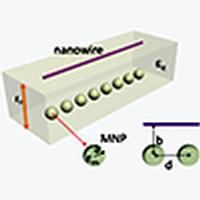当前位置:
X-MOL 学术
›
J. Opt. Soc. Amer. B
›
论文详情
Our official English website, www.x-mol.net, welcomes your
feedback! (Note: you will need to create a separate account there.)
Plasmonic superlattices constructed by coupling electronic systems with metal nanoparticle arrays
Journal of the Optical Society of America B ( IF 1.8 ) Pub Date : 2020-02-19 , DOI: 10.1364/josab.377605 Jie Sun , Meng-Xi Zhang , Jie-Yun Yan
Journal of the Optical Society of America B ( IF 1.8 ) Pub Date : 2020-02-19 , DOI: 10.1364/josab.377605 Jie Sun , Meng-Xi Zhang , Jie-Yun Yan

|
We investigate the produced superlattice in electronic systems when coupled with metal nanoparticle arrays. The periodic potential is formed by the induced plasmonic excitations in the metal nanoparticles, with the period changing from several to hundreds of nanometers for either one- or two-dimensional cases. The theoretical method to calculate the periodic potential is presented analytically. Landau–Zener tunneling is studied in the one-dimensional case. The results show that the energy band structures of the superlattice could be designed or modified in a variety of ways, such as changing the structure parameters, combining different kinds of metal nanoparticles, and tuning the strength of the excitation field. These advantages make it a prospective platform to simulate condensed matter physics.
中文翻译:

通过将电子系统与金属纳米粒子阵列耦合而构建的等离子超晶格
当我们与金属纳米粒子阵列耦合时,我们研究电子系统中产生的超晶格。周期性电势是由金属纳米颗粒中的感应等离子体激元激发形成的,对于一维或二维情况,周期从几纳米变为几百纳米。分析性地提出了计算周期性电势的理论方法。一维情况下研究了Landau-Zener隧道技术。结果表明,可以通过多种方式设计或修改超晶格的能带结构,例如改变结构参数,结合不同种类的金属纳米粒子以及调节激发场的强度。这些优势使其成为模拟凝聚态物理的理想平台。
更新日期:2020-03-02
中文翻译:

通过将电子系统与金属纳米粒子阵列耦合而构建的等离子超晶格
当我们与金属纳米粒子阵列耦合时,我们研究电子系统中产生的超晶格。周期性电势是由金属纳米颗粒中的感应等离子体激元激发形成的,对于一维或二维情况,周期从几纳米变为几百纳米。分析性地提出了计算周期性电势的理论方法。一维情况下研究了Landau-Zener隧道技术。结果表明,可以通过多种方式设计或修改超晶格的能带结构,例如改变结构参数,结合不同种类的金属纳米粒子以及调节激发场的强度。这些优势使其成为模拟凝聚态物理的理想平台。











































 京公网安备 11010802027423号
京公网安备 11010802027423号